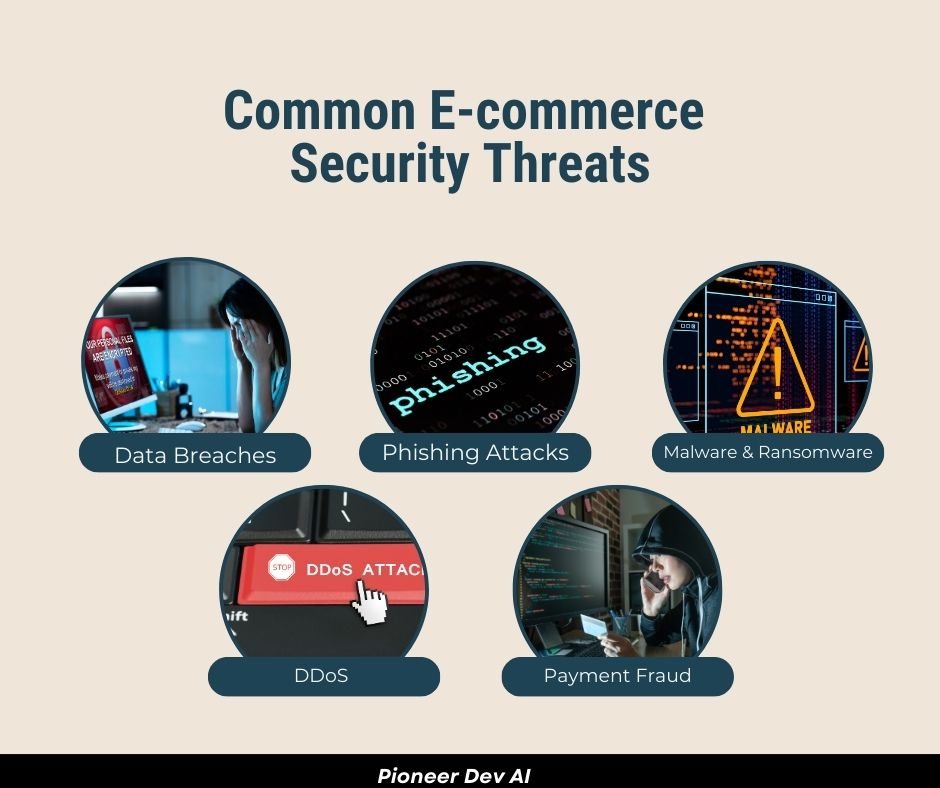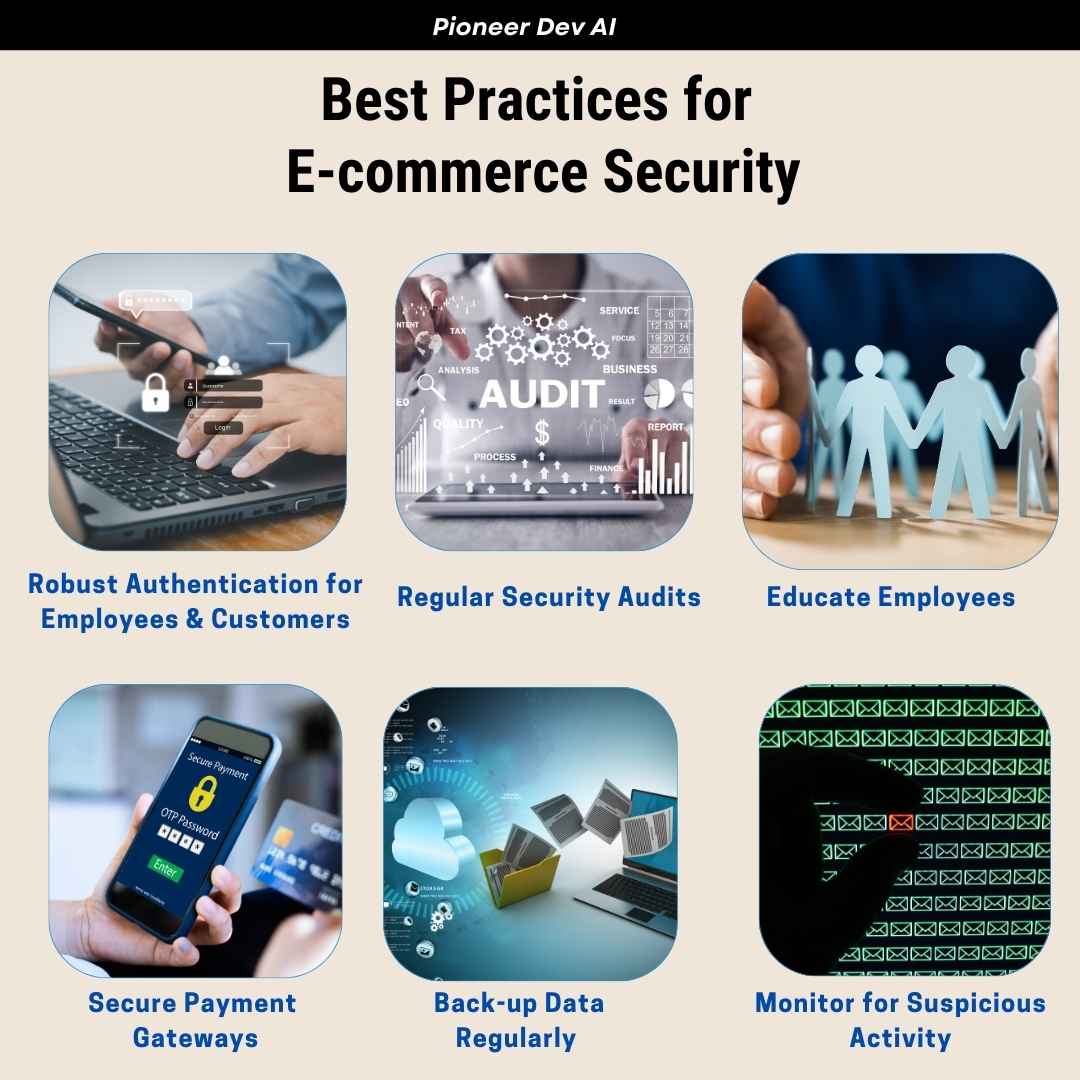Effective E-commerce Security: Best Practices For Your Business
E-commerce security has become a fundamental pillar for businesses striving to succeed online. The rapid rise of e-commerce has brought not only convenience and growth but also an alarming increase in cyber threats.
Cybercriminals are continuously evolving their tactics, targeting online stores with fraud, data breaches, and payment scams. As businesses increasingly rely on digital transactions, the need for robust e-commerce security measures has never been more crucial.
A single security breach can have devastating consequences, from financial losses to irreversible reputational damage. According to recent reports, the e-commerce security market for fraud detection and prevention is projected to exceed $69 billion by 2025 , underscoring the gravity of these threats. Beyond the financial risks, compromised customer data can erode trust and loyalty, leaving businesses vulnerable to long-term damage.
This article will explore the critical importance of e-commerce security and offer key strategies to safeguard your business and customers against the rising tide of cyber threats.
Understanding E-commerce Security
E-commerce security refers to the comprehensive measures and protocols that safeguard online transactions, ensuring the protection of both customers and businesses from cyber threats. It encompasses a wide range of practices, including data protection, encryption, and authentication, which are critical in preserving the integrity of sensitive customer information such as payment details and personal data.
To better understand the difference between e-commerce security and e-commerce cyber security, think of them as two layers of protection for online businesses.
E-commerce security is like the overall safety plan that covers everything from making sure online payments are processed securely to keeping customer information private. For example, when you buy something online, e-commerce security ensures that your credit card information is encrypted and stored safely, so no one else can access it.
On the other hand, e-commerce cyber security is more focused on defending the business against specific online attacks. These attacks can include hacking, where someone tries to break into the website to steal data, phishing, where scammers trick users into giving away personal information, or malware, which are harmful programs that can infect a site.
For instance, a phishing scam might involve an email that looks like it’s from the online store, asking for your password, but it’s actually a trick to steal your information.
Common E-commerce Security Threats

E-commerce businesses face a variety of ecommerce security threats that can disrupt operations and compromise sensitive information. Here are the common security threats you need to be aware of:
Data Breaches
A data breach happens when someone unauthorized gets access to private information, like your credit card details or email addresses stored on an e-commerce website. Imagine your personal information is kept in a safe, and someone finds a way to unlock that safe. This can lead to identity theft or stolen payment details.
On average, a data breach costs companies $4.45 million , as reported by IBM in 2023.
Phishing Attacks
Phishing is like a scam where someone pretends to be a trustworthy company (like your bank or a popular shopping site) to trick you into giving away sensitive information. They often do this through fake emails or websites that look real but are designed to steal your login details or credit card info.
Malware and Ransomware
Malware is harmful software, like a virus for your computer, that can sneak onto an e-commerce site and steal data or damage the system. Ransomware is a type of malware that locks your system until you pay the attackers a ransom to regain access.
According to Astra , Ransomware attacks have increased by 13% over the past five years, with the average cost per incident reaching $1.85 million in 2023.
DDoS (Distributed Denial-of-Service) Attacks:
A DDoS attack is when hackers flood a website with so much traffic that it can’t handle it, causing the site to slow down or crash. It’s like having too many people try to enter a store at once, blocking the doors and preventing real customers from getting in.
Payment Fraud:
Payment fraud occurs when someone makes an unauthorized purchase with a stolen credit card or creates fake transactions to steal from businesses. This not only results in financial losses but can also hurt the company’s reputation if customers don’t feel safe.
According to Mastercard , ecommerce payment fraud resulted in losses of $41 million in 2022, and Juniper Research projects that this year, the global cost of ecommerce fraud to merchants will surpass $48 billion.
North America accounts for 42% of these losses by value, with Europe contributing 26%. Even more concerning for merchants, global losses from online payment fraud are expected to exceed $343 billion between now and 2027.
You May Also Read: AI in E-commerce
Best Practices for E-commerce Security

To protect your business and customers from eCommerce security threats, it’s essential to adopt a proactive approach to securing your website and systems. Here are some practical, easy-to-understand steps to enhance your eCommerce security:
Have a Robust Authentication for Employees:
Make sure your employees use strong passwords and two-factor authentication (2FA). This adds an extra layer of protection, ensuring that even if someone steals a password, they can’t access important systems without a second form of verification.
Example: Use password managers to help employees create and store strong, unique passwords.
Implement Strong Authentication for Customers:
Enable multi-factor authentication (MFA) for customers. MFA asks users to verify their identity using something they know (like a password) and something they have (like a phone or email code). This keeps user accounts secure, even if their password is stolen.
Example: Offer MFA as an option at checkout to reduce the risk of unauthorized transactions.
Regular Security Audits:
Conduct frequent checks to identify any weaknesses in your system before hackers find them. Security audits can reveal gaps in your eCommerce website security, such as outdated software or weak access controls.
Example: Schedule security audits at least twice a year or after any major changes to your website.
Educate Employees:
Train your team to recognize eCommerce cyber security threats like phishing emails or suspicious links. Employees who understand these risks are less likely to fall victim to cyberattacks.
Example: Hold regular workshops or provide online training courses to keep everyone up to date on the latest security threats.
Secure Payment Gateways:
Use trusted payment processors, and ensure your website complies with PCI DSS (Payment Card Industry Data Security Standard). This helps protect sensitive customer information like credit card numbers during online transactions.
Example: Always use SSL (Secure Sockets Layer) certificates to encrypt payment information and display the padlock symbol in the URL bar.
Back Up Data Regularly:
In case of a data breach, malware attack, or accidental data loss, having backups ensures you can quickly restore your site and minimize downtime. Make sure your backups are encrypted and stored securely.
Example: Automate daily backups and store them in a separate location from your main system.
Monitor for Suspicious Activity:
Use monitoring tools to keep an eye on your website for unusual behavior, such as multiple failed login attempts or large amounts of traffic from suspicious sources. This helps detect and stop potential attacks early.
Example: Set up alerts that notify you of any unusual activity, so you can respond quickly before damage is done.
By following these best practices, businesses can significantly reduce the risk of eCommerce security threats, ensuring a safer experience for both customers and their operations.
Building Customer Trust Through Security
E-commerce security is not just a technical requirement; it is a cornerstone of building customer trust and loyalty. When customers shop online, they share sensitive information, such as credit card details and personal addresses.
If they feel their data is at risk, they are likely to abandon their cart and seek safer alternatives. Implementing robust E-commerce website security measures demonstrates to customers that their safety is a top priority, fostering a sense of security that encourages them to make purchases confidently.
Transparent security practices play a crucial role in enhancing customer confidence. For instance, displaying security certifications, using SSL certificates for secure transactions, and clearly communicating data protection policies can significantly influence a customer’s decision to complete a transaction.
When customers see that a business is upfront about its security measures and is proactive in protecting their data, they are more likely to trust the brand, leading to repeat purchases and long-term loyalty.
Pioneer Dev AI can be a valuable partner in securing your e-commerce business against security threats. We specialize in developing customized security solutions that safeguard sensitive customer information and enhance eCommerce cyber security measures.
By partnering with us, you can not only protect your e-commerce platform but also foster an environment of trust and safety that keeps your customers coming back. Our mission is to help businesses enhance customer loyalty and drives business growth.

